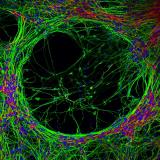As the Australian Government's lead agency for funding health and medical research, the National Health and Medical Research Council (NHMRC) is committed to achieving gender equity in its grant program.
A health and medical research sector that is equitable, gender inclusive,1 and enriched by diversity – where research design, participation, and workforce reflect and respond to the full spectrum of lived experiences and talents needed to build a healthy Australia.
NHMRC-led action and funding promote gender equity in Australia’s health and medical research and the research workforce.
- Gender equity strengthens health and medical research and the research workforce.
- Diversity in health and medical research and the research workforce will lead to better health outcomes for the Australian community.
- Everyone benefits from research environments that are safe, respectful and inclusive for researchers and participants.
- Evaluate and adapt NHMRC policies and activities to achieve gender equity and measure our performance against set goals.
- Increase transparency of NHMRC processes and funding outcomes.
- Build commitment to gender equity as a common goal across the health and medical research sector.
- Collaborate with government, research institutions, industry, business and the community to achieve gender equity.
Goal: NHMRC grants support gender equity in health and medical research
Actions:
- Maintain or strengthen funding policies and processes that promote gender equity in NHMRC-funded research teams and research, including research participants.
- Strengthen guidance and training for peer reviewers to consider track record relative to opportunity, including career disruptions and circumstances.
- Continue to apply special measures2 under the Sex Discrimination Act 1984 to facilitate gender equity in the grant program, until the data demonstrates they are no longer required.
KPI: Improved gender equity in the research and researchers NHMRC funds.
Goal: NHMRC actions and initiatives are based on transparent evidence.
Actions:
- Maintain or strengthen transparency in reporting on NHMRC grant applications and outcomes by gender.
- Collect and use data to understand structural disadvantages by gender, considering the impact of intersectionality, to inform policy and process improvements.
- Pilot and evaluate new initiatives to strengthen the evidence base on effective interventions.
KPI: Transparent data are available to the sector and used by NHMRC to support initiatives that foster gender equity in research.
Goal: Health and medical research environments are safe, respectful and inclusive, and gender equity is recognised as a common goal
Actions:
- Engage with others to encourage the advancement of gender equity and inclusion in research and the research workforce.
- Consider national and international initiatives that are achieving gender equity and inclusion.
- Maintain NHMRC requirements for Administering Institutions’ gender policies and report on their effectiveness.
- Raise the profile of gender positive role models.
KPI: NHMRC promotes gender equity and inclusion in the health and medical research sector.
1 Gender inclusive refers to creating environments where people of any gender identity feel acknowledged and valued, including women and men, cis- and trans-gender, and non-binary and gender diverse people.
2 Under the Sex Discrimination Act 1984, special measures refer to positive actions taken with the purpose of achieving substantive equality.


